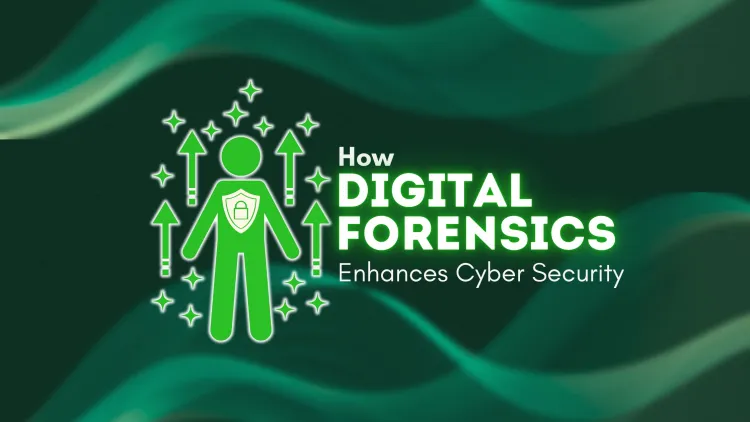How Digital Forensics Enhances Cybersecurity? Investigations, Recoveries, and Legal Compliance
Digital forensics plays an essential role in modern cybersecurity by investigating, analyzing, and preserving digital evidence related to cybercrimes. It helps organizations detect cyber threats, recover from data breaches, ensure legal compliance, and strengthen overall security measures. While cybersecurity focuses on preventing cyber incidents, digital forensics deals with analyzing and solving issues after they have occurred. By using advanced tools and techniques, digital forensics professionals provide invaluable insights into cybercrimes, ensuring organizations can learn from past incidents to prevent future attacks. It is an ever-evolving field that is crucial for both cyber defense and legal proceedings.

Digital forensics is a cornerstone of modern cybersecurity, providing the methods and tools to investigate, understand, and counteract cyber threats. As cyberattacks grow more sophisticated, digital forensics plays a vital role in minimizing their impact and ensuring accountability. This blog explores how digital forensics makes a difference in cybersecurity by enhancing investigation capabilities, safeguarding sensitive information, and strengthening defenses.
What Is Digital Forensics in Cybersecurity?
Digital forensics is the science of collecting, preserving, analyzing, and presenting digital evidence. It is used to investigate cybercrimes, ensure compliance with legal standards, and recover from security breaches.
Digital Forensics vs. Cybersecurity
While digital forensics and cybersecurity are closely related, they serve different purposes:
| Aspect | Digital Forensics | Cybersecurity |
|---|---|---|
| Objective | Investigate and analyze incidents post-occurrence. | Prevent and protect systems from cyber threats. |
| Focus Area | Evidence recovery, analysis, and legal reporting. | Proactive defense, threat prevention, and risk mitigation. |
| Approach | Reactive: Deals with incidents that have already occurred. | Proactive: Focuses on preventing incidents before they happen. |
| Tools | EnCase, FTK, Autopsy, Cellebrite. | Firewalls, antivirus software, SIEM tools. |
| Timeframe | Post-incident investigation. | Pre-incident and ongoing protection. |
| Legal Component | Strong focus on legal standards and evidence handling. | Emphasis on compliance but less direct interaction with courts. |
Why Digital Forensics Matters in Cybersecurity
Digital forensics is essential for maintaining a robust security posture in organizations. Here’s how it makes a difference:
1. Detecting Cyber Threats
Digital forensics enables organizations to identify unusual activities and security incidents. Forensic tools analyze system logs to detect unauthorized access or malware infections.
| Cyber Threat | How Digital Forensics Helps |
|---|---|
| Phishing Attacks | Traces the source of malicious emails. |
| Malware Infections | Identifies and isolates malicious software. |
| Insider Threats | Tracks unauthorized data access by employees. |
2. Investigating Cybercrimes
Digital forensics provides a structured approach to investigate cybercrimes like ransomware, hacking, and fraud. It collects evidence to identify perpetrators and their methods, ensuring a comprehensive understanding of the incident.
3. Strengthening Legal Compliance
Organizations must comply with data protection laws such as GDPR or HIPAA. Digital forensics helps maintain a proper chain of custody for evidence, ensuring it is legally admissible in court. This safeguards organizations against potential legal liabilities.
4. Recovering From Data Breaches
When sensitive data is compromised, digital forensics helps organizations assess the scope of the breach, recover lost data, and restore normal operations.
5. Enhancing Incident Response
Digital forensics is an integral part of the Incident Response Lifecycle, ensuring that incidents are contained, investigated, and mitigated efficiently.
The Role of Tools in Digital Forensics
Forensic investigations rely on specialized tools to analyze systems, recover evidence, and ensure accuracy.
| Tool | Purpose |
|---|---|
| EnCase | Disk imaging and evidence recovery. |
| Wireshark | Network traffic analysis. |
| FTK | Comprehensive analysis of emails and files. |
| Autopsy | Open-source tool for forensic investigations. |
| Splunk | Log monitoring and anomaly detection. |
Real-Life Example: Investigating a Ransomware Attack
Let’s illustrate how digital forensics makes a difference with a ransomware scenario:
Incident: An organization’s critical files are encrypted by ransomware.
Steps in the Investigation:
- Detection: Logs show unauthorized access to the server at midnight.
- Containment: The affected systems are isolated from the network.
- Eradication: Malware analysis reveals the ransomware’s origin and encryption method.
- Recovery: Clean backups restore encrypted files.
- Lessons Learned: Security protocols are updated to prevent future attacks.
Digital forensics ensures a thorough investigation, helping the organization recover and fortify its defenses.
Challenges in Digital Forensics
While highly effective, digital forensics faces challenges such as:
- Data Volume: Analyzing massive amounts of data.
- Encryption: Overcoming encrypted files and devices.
- Evolving Threats: Keeping up with new attack techniques.
Future of Digital Forensics
As technology evolves, so does digital forensics. Advancements in artificial intelligence, cloud forensics, and automation will enhance investigative capabilities, making it easier to counteract sophisticated cyber threats.
Conclusion
Digital forensics is indispensable in cybersecurity, playing a crucial role in detecting threats, investigating incidents, ensuring compliance, and recovering from attacks. By employing the right skills and tools, professionals can safeguard organizations from cybercrime and create a more secure digital landscape.
Whether you’re a student exploring this field or a professional honing your expertise, investing in digital forensics will empower you to make a meaningful impact in the fight against cyber threats.
FAQ's












![Top 10 Ethical Hackers in the World [2025]](https://www.webasha.com/blog/uploads/images/202408/image_100x75_66c2f983c207b.webp)

![[2025] Top 100+ VAPT Interview Questions and Answers](https://www.webasha.com/blog/uploads/images/image_100x75_6512b1e4b64f7.jpg)









